Girls at War: Analysis of Chinua Achebe's Political Nigerian Culture
VerifiedAdded on 2023/06/14
|6
|1623
|66
AI Summary
This essay provides an analysis of Chinua Achebe's 'Girls at War', a story of political Nigerian culture, war, and corruption. The essay explores the characters, themes, and plot of the story, highlighting the struggle of Africans against foreign forces and the role of women in war. The author's use of language and literary devices is also discussed.
Contribute Materials
Your contribution can guide someone’s learning journey. Share your
documents today.
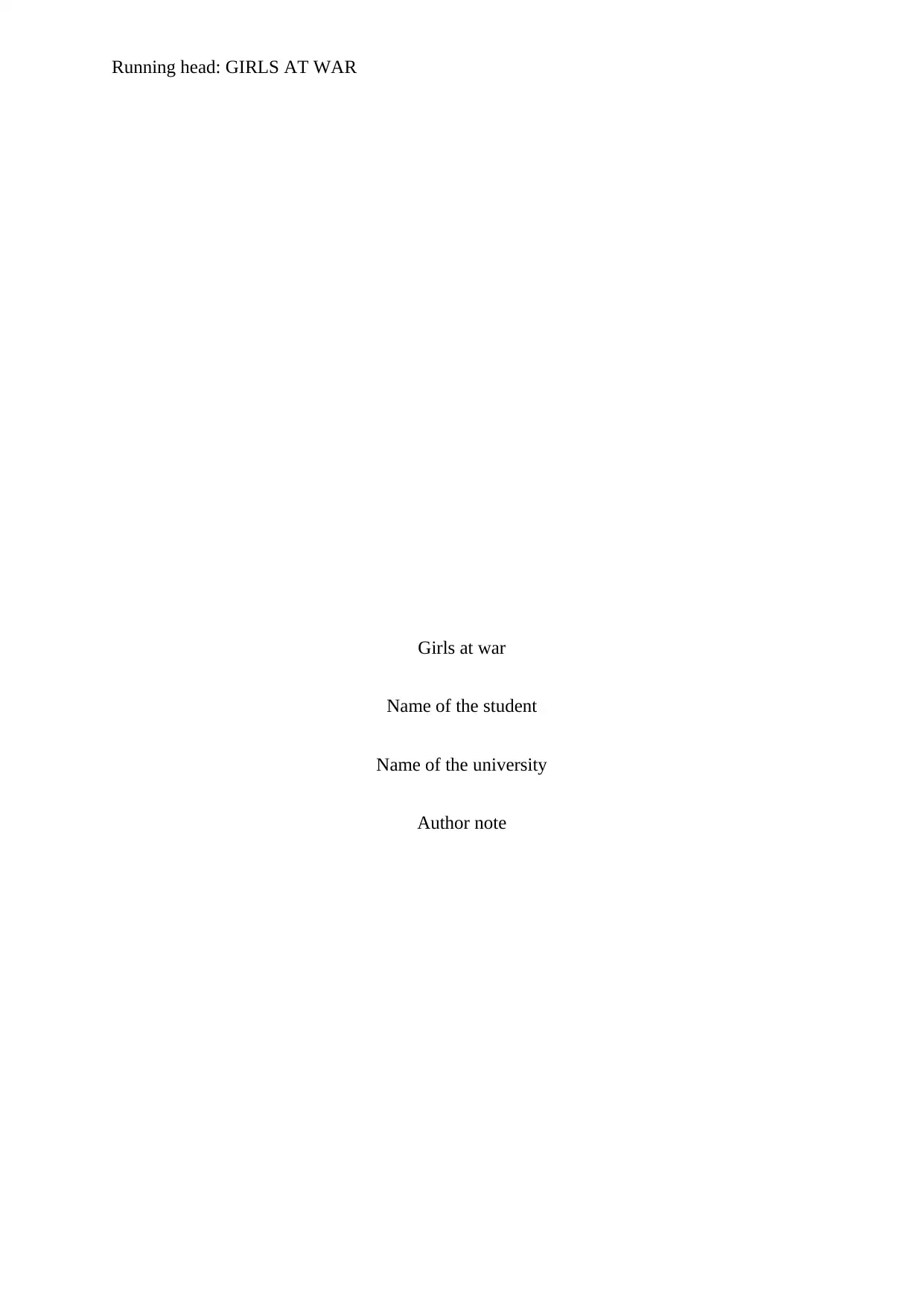
Running head: GIRLS AT WAR
Girls at war
Name of the student
Name of the university
Author note
Girls at war
Name of the student
Name of the university
Author note
Secure Best Marks with AI Grader
Need help grading? Try our AI Grader for instant feedback on your assignments.
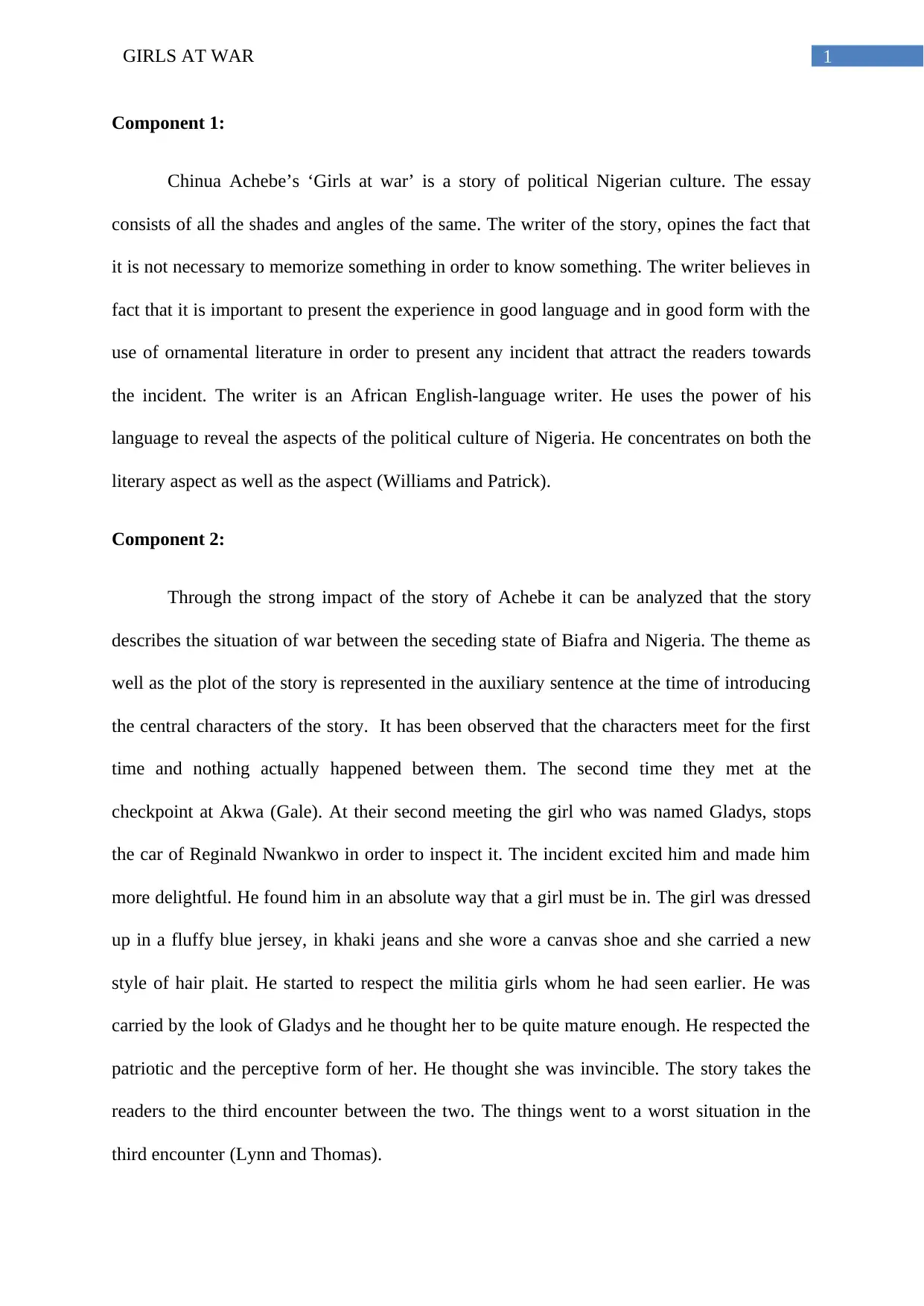
1GIRLS AT WAR
Component 1:
Chinua Achebe’s ‘Girls at war’ is a story of political Nigerian culture. The essay
consists of all the shades and angles of the same. The writer of the story, opines the fact that
it is not necessary to memorize something in order to know something. The writer believes in
fact that it is important to present the experience in good language and in good form with the
use of ornamental literature in order to present any incident that attract the readers towards
the incident. The writer is an African English-language writer. He uses the power of his
language to reveal the aspects of the political culture of Nigeria. He concentrates on both the
literary aspect as well as the aspect (Williams and Patrick).
Component 2:
Through the strong impact of the story of Achebe it can be analyzed that the story
describes the situation of war between the seceding state of Biafra and Nigeria. The theme as
well as the plot of the story is represented in the auxiliary sentence at the time of introducing
the central characters of the story. It has been observed that the characters meet for the first
time and nothing actually happened between them. The second time they met at the
checkpoint at Akwa (Gale). At their second meeting the girl who was named Gladys, stops
the car of Reginald Nwankwo in order to inspect it. The incident excited him and made him
more delightful. He found him in an absolute way that a girl must be in. The girl was dressed
up in a fluffy blue jersey, in khaki jeans and she wore a canvas shoe and she carried a new
style of hair plait. He started to respect the militia girls whom he had seen earlier. He was
carried by the look of Gladys and he thought her to be quite mature enough. He respected the
patriotic and the perceptive form of her. He thought she was invincible. The story takes the
readers to the third encounter between the two. The things went to a worst situation in the
third encounter (Lynn and Thomas).
Component 1:
Chinua Achebe’s ‘Girls at war’ is a story of political Nigerian culture. The essay
consists of all the shades and angles of the same. The writer of the story, opines the fact that
it is not necessary to memorize something in order to know something. The writer believes in
fact that it is important to present the experience in good language and in good form with the
use of ornamental literature in order to present any incident that attract the readers towards
the incident. The writer is an African English-language writer. He uses the power of his
language to reveal the aspects of the political culture of Nigeria. He concentrates on both the
literary aspect as well as the aspect (Williams and Patrick).
Component 2:
Through the strong impact of the story of Achebe it can be analyzed that the story
describes the situation of war between the seceding state of Biafra and Nigeria. The theme as
well as the plot of the story is represented in the auxiliary sentence at the time of introducing
the central characters of the story. It has been observed that the characters meet for the first
time and nothing actually happened between them. The second time they met at the
checkpoint at Akwa (Gale). At their second meeting the girl who was named Gladys, stops
the car of Reginald Nwankwo in order to inspect it. The incident excited him and made him
more delightful. He found him in an absolute way that a girl must be in. The girl was dressed
up in a fluffy blue jersey, in khaki jeans and she wore a canvas shoe and she carried a new
style of hair plait. He started to respect the militia girls whom he had seen earlier. He was
carried by the look of Gladys and he thought her to be quite mature enough. He respected the
patriotic and the perceptive form of her. He thought she was invincible. The story takes the
readers to the third encounter between the two. The things went to a worst situation in the
third encounter (Lynn and Thomas).
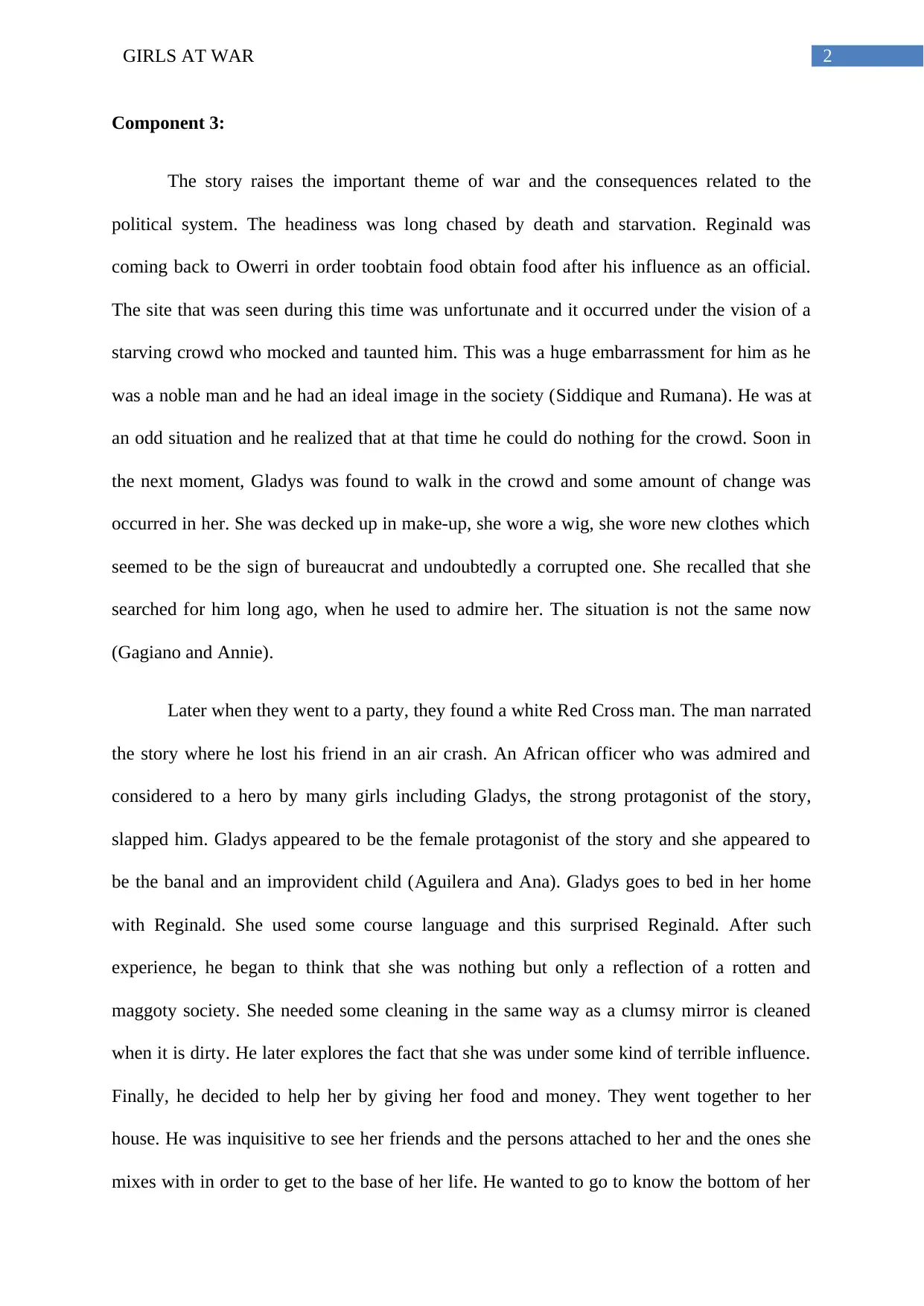
2GIRLS AT WAR
Component 3:
The story raises the important theme of war and the consequences related to the
political system. The headiness was long chased by death and starvation. Reginald was
coming back to Owerri in order toobtain food obtain food after his influence as an official.
The site that was seen during this time was unfortunate and it occurred under the vision of a
starving crowd who mocked and taunted him. This was a huge embarrassment for him as he
was a noble man and he had an ideal image in the society (Siddique and Rumana). He was at
an odd situation and he realized that at that time he could do nothing for the crowd. Soon in
the next moment, Gladys was found to walk in the crowd and some amount of change was
occurred in her. She was decked up in make-up, she wore a wig, she wore new clothes which
seemed to be the sign of bureaucrat and undoubtedly a corrupted one. She recalled that she
searched for him long ago, when he used to admire her. The situation is not the same now
(Gagiano and Annie).
Later when they went to a party, they found a white Red Cross man. The man narrated
the story where he lost his friend in an air crash. An African officer who was admired and
considered to a hero by many girls including Gladys, the strong protagonist of the story,
slapped him. Gladys appeared to be the female protagonist of the story and she appeared to
be the banal and an improvident child (Aguilera and Ana). Gladys goes to bed in her home
with Reginald. She used some course language and this surprised Reginald. After such
experience, he began to think that she was nothing but only a reflection of a rotten and
maggoty society. She needed some cleaning in the same way as a clumsy mirror is cleaned
when it is dirty. He later explores the fact that she was under some kind of terrible influence.
Finally, he decided to help her by giving her food and money. They went together to her
house. He was inquisitive to see her friends and the persons attached to her and the ones she
mixes with in order to get to the base of her life. He wanted to go to know the bottom of her
Component 3:
The story raises the important theme of war and the consequences related to the
political system. The headiness was long chased by death and starvation. Reginald was
coming back to Owerri in order toobtain food obtain food after his influence as an official.
The site that was seen during this time was unfortunate and it occurred under the vision of a
starving crowd who mocked and taunted him. This was a huge embarrassment for him as he
was a noble man and he had an ideal image in the society (Siddique and Rumana). He was at
an odd situation and he realized that at that time he could do nothing for the crowd. Soon in
the next moment, Gladys was found to walk in the crowd and some amount of change was
occurred in her. She was decked up in make-up, she wore a wig, she wore new clothes which
seemed to be the sign of bureaucrat and undoubtedly a corrupted one. She recalled that she
searched for him long ago, when he used to admire her. The situation is not the same now
(Gagiano and Annie).
Later when they went to a party, they found a white Red Cross man. The man narrated
the story where he lost his friend in an air crash. An African officer who was admired and
considered to a hero by many girls including Gladys, the strong protagonist of the story,
slapped him. Gladys appeared to be the female protagonist of the story and she appeared to
be the banal and an improvident child (Aguilera and Ana). Gladys goes to bed in her home
with Reginald. She used some course language and this surprised Reginald. After such
experience, he began to think that she was nothing but only a reflection of a rotten and
maggoty society. She needed some cleaning in the same way as a clumsy mirror is cleaned
when it is dirty. He later explores the fact that she was under some kind of terrible influence.
Finally, he decided to help her by giving her food and money. They went together to her
house. He was inquisitive to see her friends and the persons attached to her and the ones she
mixes with in order to get to the base of her life. He wanted to go to know the bottom of her
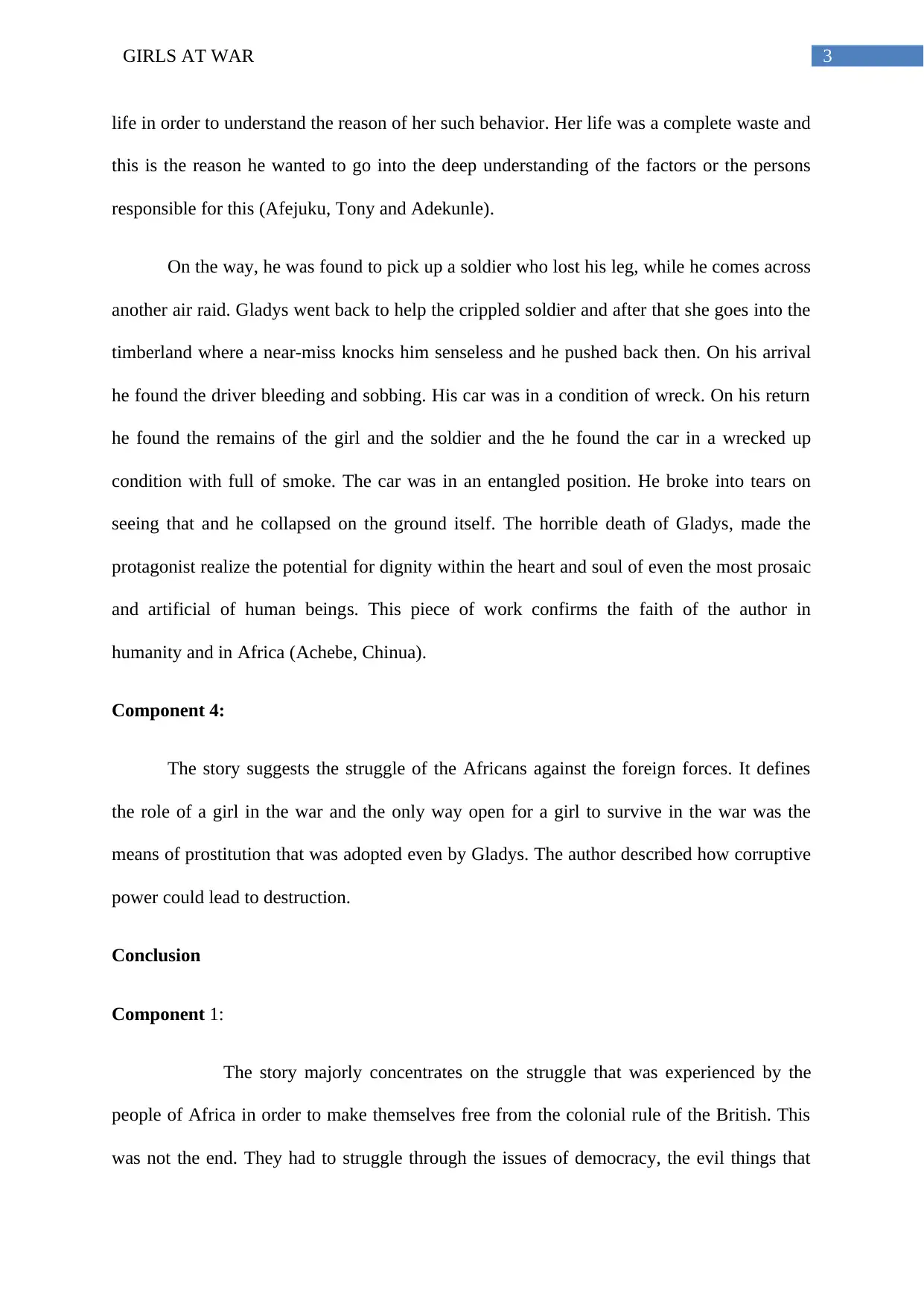
3GIRLS AT WAR
life in order to understand the reason of her such behavior. Her life was a complete waste and
this is the reason he wanted to go into the deep understanding of the factors or the persons
responsible for this (Afejuku, Tony and Adekunle).
On the way, he was found to pick up a soldier who lost his leg, while he comes across
another air raid. Gladys went back to help the crippled soldier and after that she goes into the
timberland where a near-miss knocks him senseless and he pushed back then. On his arrival
he found the driver bleeding and sobbing. His car was in a condition of wreck. On his return
he found the remains of the girl and the soldier and the he found the car in a wrecked up
condition with full of smoke. The car was in an entangled position. He broke into tears on
seeing that and he collapsed on the ground itself. The horrible death of Gladys, made the
protagonist realize the potential for dignity within the heart and soul of even the most prosaic
and artificial of human beings. This piece of work confirms the faith of the author in
humanity and in Africa (Achebe, Chinua).
Component 4:
The story suggests the struggle of the Africans against the foreign forces. It defines
the role of a girl in the war and the only way open for a girl to survive in the war was the
means of prostitution that was adopted even by Gladys. The author described how corruptive
power could lead to destruction.
Conclusion
Component 1:
The story majorly concentrates on the struggle that was experienced by the
people of Africa in order to make themselves free from the colonial rule of the British. This
was not the end. They had to struggle through the issues of democracy, the evil things that
life in order to understand the reason of her such behavior. Her life was a complete waste and
this is the reason he wanted to go into the deep understanding of the factors or the persons
responsible for this (Afejuku, Tony and Adekunle).
On the way, he was found to pick up a soldier who lost his leg, while he comes across
another air raid. Gladys went back to help the crippled soldier and after that she goes into the
timberland where a near-miss knocks him senseless and he pushed back then. On his arrival
he found the driver bleeding and sobbing. His car was in a condition of wreck. On his return
he found the remains of the girl and the soldier and the he found the car in a wrecked up
condition with full of smoke. The car was in an entangled position. He broke into tears on
seeing that and he collapsed on the ground itself. The horrible death of Gladys, made the
protagonist realize the potential for dignity within the heart and soul of even the most prosaic
and artificial of human beings. This piece of work confirms the faith of the author in
humanity and in Africa (Achebe, Chinua).
Component 4:
The story suggests the struggle of the Africans against the foreign forces. It defines
the role of a girl in the war and the only way open for a girl to survive in the war was the
means of prostitution that was adopted even by Gladys. The author described how corruptive
power could lead to destruction.
Conclusion
Component 1:
The story majorly concentrates on the struggle that was experienced by the
people of Africa in order to make themselves free from the colonial rule of the British. This
was not the end. They had to struggle through the issues of democracy, the evil things that
Secure Best Marks with AI Grader
Need help grading? Try our AI Grader for instant feedback on your assignments.
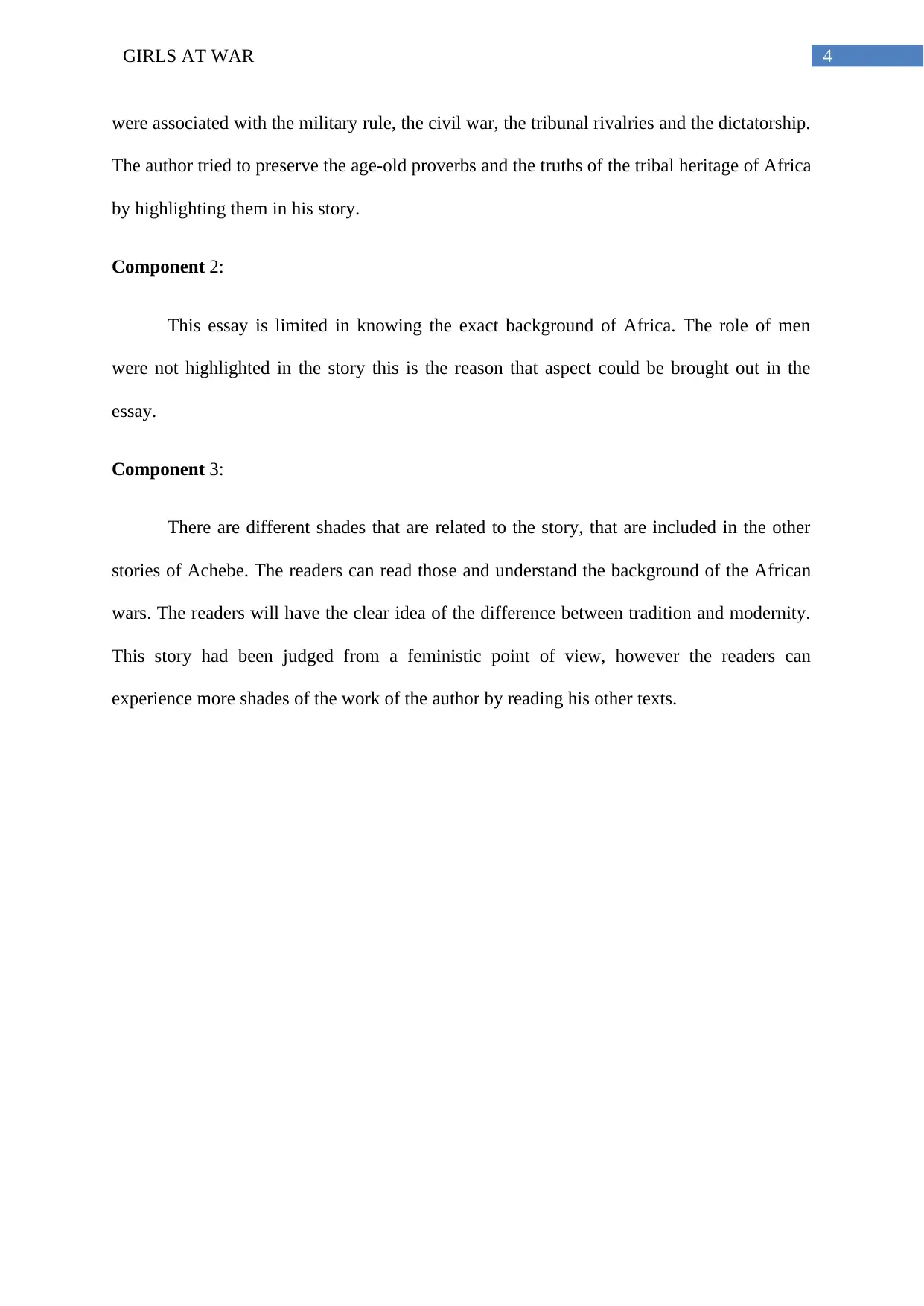
4GIRLS AT WAR
were associated with the military rule, the civil war, the tribunal rivalries and the dictatorship.
The author tried to preserve the age-old proverbs and the truths of the tribal heritage of Africa
by highlighting them in his story.
Component 2:
This essay is limited in knowing the exact background of Africa. The role of men
were not highlighted in the story this is the reason that aspect could be brought out in the
essay.
Component 3:
There are different shades that are related to the story, that are included in the other
stories of Achebe. The readers can read those and understand the background of the African
wars. The readers will have the clear idea of the difference between tradition and modernity.
This story had been judged from a feministic point of view, however the readers can
experience more shades of the work of the author by reading his other texts.
were associated with the military rule, the civil war, the tribunal rivalries and the dictatorship.
The author tried to preserve the age-old proverbs and the truths of the tribal heritage of Africa
by highlighting them in his story.
Component 2:
This essay is limited in knowing the exact background of Africa. The role of men
were not highlighted in the story this is the reason that aspect could be brought out in the
essay.
Component 3:
There are different shades that are related to the story, that are included in the other
stories of Achebe. The readers can read those and understand the background of the African
wars. The readers will have the clear idea of the difference between tradition and modernity.
This story had been judged from a feministic point of view, however the readers can
experience more shades of the work of the author by reading his other texts.
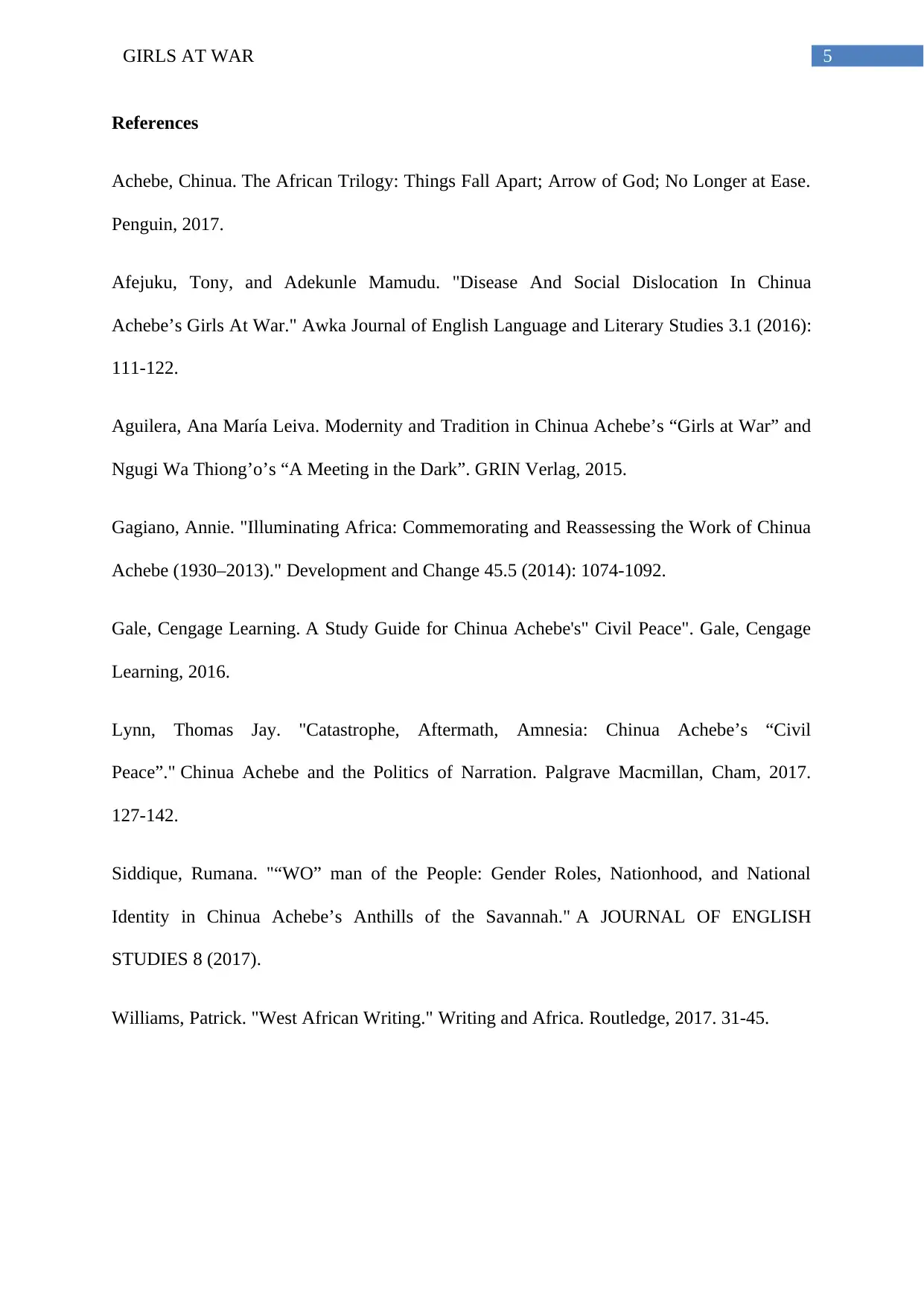
5GIRLS AT WAR
References
Achebe, Chinua. The African Trilogy: Things Fall Apart; Arrow of God; No Longer at Ease.
Penguin, 2017.
Afejuku, Tony, and Adekunle Mamudu. "Disease And Social Dislocation In Chinua
Achebe’s Girls At War." Awka Journal of English Language and Literary Studies 3.1 (2016):
111-122.
Aguilera, Ana María Leiva. Modernity and Tradition in Chinua Achebe’s “Girls at War” and
Ngugi Wa Thiong’o’s “A Meeting in the Dark”. GRIN Verlag, 2015.
Gagiano, Annie. "Illuminating Africa: Commemorating and Reassessing the Work of Chinua
Achebe (1930–2013)." Development and Change 45.5 (2014): 1074-1092.
Gale, Cengage Learning. A Study Guide for Chinua Achebe's" Civil Peace". Gale, Cengage
Learning, 2016.
Lynn, Thomas Jay. "Catastrophe, Aftermath, Amnesia: Chinua Achebe’s “Civil
Peace”." Chinua Achebe and the Politics of Narration. Palgrave Macmillan, Cham, 2017.
127-142.
Siddique, Rumana. "“WO” man of the People: Gender Roles, Nationhood, and National
Identity in Chinua Achebe’s Anthills of the Savannah." A JOURNAL OF ENGLISH
STUDIES 8 (2017).
Williams, Patrick. "West African Writing." Writing and Africa. Routledge, 2017. 31-45.
References
Achebe, Chinua. The African Trilogy: Things Fall Apart; Arrow of God; No Longer at Ease.
Penguin, 2017.
Afejuku, Tony, and Adekunle Mamudu. "Disease And Social Dislocation In Chinua
Achebe’s Girls At War." Awka Journal of English Language and Literary Studies 3.1 (2016):
111-122.
Aguilera, Ana María Leiva. Modernity and Tradition in Chinua Achebe’s “Girls at War” and
Ngugi Wa Thiong’o’s “A Meeting in the Dark”. GRIN Verlag, 2015.
Gagiano, Annie. "Illuminating Africa: Commemorating and Reassessing the Work of Chinua
Achebe (1930–2013)." Development and Change 45.5 (2014): 1074-1092.
Gale, Cengage Learning. A Study Guide for Chinua Achebe's" Civil Peace". Gale, Cengage
Learning, 2016.
Lynn, Thomas Jay. "Catastrophe, Aftermath, Amnesia: Chinua Achebe’s “Civil
Peace”." Chinua Achebe and the Politics of Narration. Palgrave Macmillan, Cham, 2017.
127-142.
Siddique, Rumana. "“WO” man of the People: Gender Roles, Nationhood, and National
Identity in Chinua Achebe’s Anthills of the Savannah." A JOURNAL OF ENGLISH
STUDIES 8 (2017).
Williams, Patrick. "West African Writing." Writing and Africa. Routledge, 2017. 31-45.
1 out of 6
Your All-in-One AI-Powered Toolkit for Academic Success.
+13062052269
info@desklib.com
Available 24*7 on WhatsApp / Email
![[object Object]](/_next/static/media/star-bottom.7253800d.svg)
Unlock your academic potential
© 2024 | Zucol Services PVT LTD | All rights reserved.
